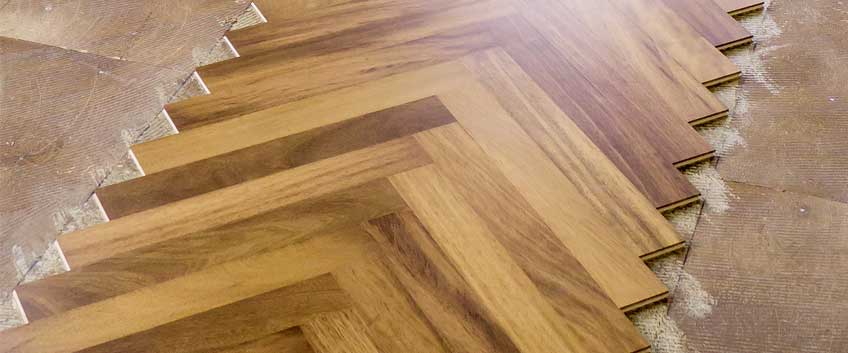
The herringbone pattern is among the most popular and beautiful patterns for parquet flooring. Many people prefer herringbone patterns because of the unique and one-of-a-kind appearance they give to any space, where installed. However, as with most of the parquet patterns, herringbone is pretty complex and hard to install, when done with the old-school method. Even the most enthusiastic DIY-ers are not very keen on the idea to try and attempt this at home, while professional installation service may cost a lot and this is a serious reason for people being put off by the idea of having a professional parquet floor installation. Worry not, because today our experienced and knowledgeable fitters are going to share with you their best-kept secrets and the easiest and simplest method for installing a herringbone-patterned parquet floor in a step-by-step guide. Let’s get started!
Cutting the boards to length
First things first, you have to measure and cut the boards to length. When it comes to herringbone installation, all of the pieces need to be cut in the same length and the length of the pieces must be multiple of the width. Typically, planks are between 5 inches wide and 30 inches long.
Set up the template
Once the planks are cut perfectly to length, you can carry on with setting up the template. To achieve this, you have to screw a piece of scrap flooring to the base as a stopper for the boards. This will help you make sure that all boards are the same length, without the need to measure each one, piece by piece. Periodically make sure that the stopper piece hasn’t shifted.
Routing the ends
So, you just cut the planks and now the ends don’t have a groove and you need to make your own. To do this, you need a router. To make sure you set the router to the right depth, make sure to use as a sample a piece of wood from the factory that already has a groove, so the new groove you have just made will match the already existing groove.
Bevelling the ends
The next thing you have to do is beveling the ends. Use as an example a piece of flooring from the factory, it will usually have a micro-bevel at all four sides. Bevelling your planks consists of using a sanding block by hand or with a sander if you are pretty experienced. The just-made bevels will also need to be stained to match the other levels. The easiest way to achieve that is by using a staining pen.
Center line
The time has come to start with the layout. Start with measuring and making the centre of the room from both sides. Then use chalk to make a line across these points you will then use as a guide. Try to keep this chalk line not smudged.
Trammel points
Next thing, make a perpendicular line from the centre of the room by using trammel points and a long straight piece of hardwood flooring. Start with separating the trammel points a few feet apart and use them to mark an equal distance on both sides of the centre point. When you reach the end of the board, you can extend the trammel points. Place the trammel points on the mark you have just made and draw an arc cross where the centre perpendicular line will be from both sides of the points. No chalk a perpendicular line using the points where the arc meets from both sides. As above mentioned, use the trammel points to find the intersecting points of the four right triangles. If this is done properly, all of these lines will meet perfectly at the centre point in the room.
Border lines
As you may know, you must leave some room at the borders of the room and next to the walls for an extension gap to be done properly. You can also add border lines to the design that can be with different widths of boards. Let’s take a 5-board width for example. To mark these lines, you are going to need to measure the proper distance from the centre lines, not from the walls.
Stay tuned for part 2 of the series!